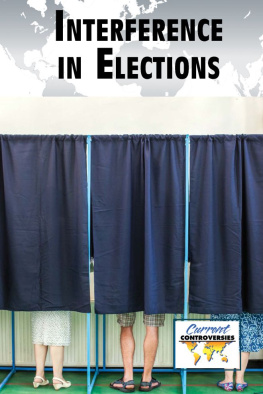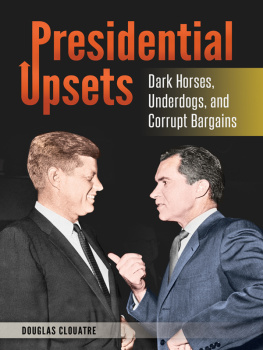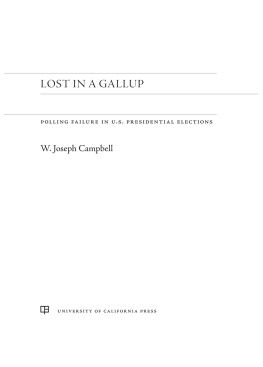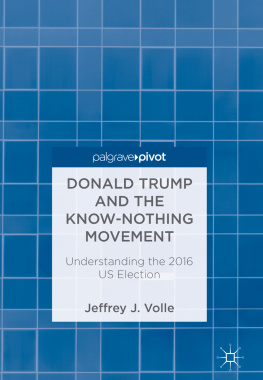ABOUT THE CONTRIBUTORS
John Agnew is professor of geography at the University of California, Los Angeles.
Ben Anderstone is a political consultant based in Seattle, Washington.
J. Clark Archer is professor of geography, University of NebraskaLincoln.
Jill A. Archer is a retired media specialist, Lincoln Public Schools, Lincoln, Nebraska.
Matthew Balentine is a graduate student of geography at the University of North Carolina, Greensboro.
William Berentsen is professor of geography at the University of Connecticut, Storrs.
Jason Combs is professor of geography at the University of Nebraska at Kearney.
Jeffrey Crump is professor in the Housing Studies Program at the University of Minnesota.
Carl T. Dahlman is professor of geography at Miami University, Oxford.
Fiona M. Davidson is associate professor of geography at the University of Arkansas.
Lisa M. DeChano-Cook is associate professor of geography at Western Michigan University.
Matthew Engel is adjunct lecturer of geography at the University of Nebraska at Kearney.
Richard L. Engstrom is professor emeritus of political science at the University of New Orleans and research associate at the Center for the Study of Race, Ethnicity, and Gender in the Social Sciences at Duke University.
Erin H. Fouberg is professor of geography at Northern State University.
Kenneth French is assistant professor of geography at the University of WisconsinParkside.
Megan A. Gall is a social scientist at the Voting Rights Project, Lawyers Committee for Civil Rights Under Law, Washington, DC.
Mark Graham is professor of Internet geography, Oxford Internet Institute, University of Oxford, and Alan Turing Institute, London.
Scott Hale is a senior data scientist at the Oxford Internet Institute, University of Oxford, and Alan Turing Institute, London.
John Heppen is professor of geography at the University of WisconsinRiver Falls.
Ashley M. Hitt is an undergraduate student in geography at the University of Oklahoma.
Kimberly K. Johnson is a graduate student in geography at the University of Oklahoma.
Ron Johnston is professor of geography at the University of Bristol, UK.
Kelvyn Jones is professor of geography at the University of Bristol, UK.
Larry Knopp is professor of geography at the University of Washington, Tacoma.
Jonathan Leib is professor of geography at Old Dominion University.
Samuel Loftsgaarden is a geography student at the University of WisconsinEau Claire.
Chris Maier is adjunct professor of geography at South Dakota State University.
David Manley is professor of geographer at the University of Bristol, UK.
Kenneth C. Martis is professor of geography at West Virginia University.
Daniel A. McGowin is assistant professor of geography at Jacksonville State University.
Richard L. Morrill is emeritus professor of geography at the University of Washington.
Jennifer L. Patin is a development officer at the Voting Rights Project, Lawyers Committee for Civil Rights Under Law, Washington, DC.
Tony Robinson is associate professor of political science at the University of Colorado at Denver.
Fred M. Shelley is professor of geography at the University of Oklahoma.
Monica Stephens is assistant professor of geography at SUNY at Buffalo.
Li Tong is a graduate student of geography at SUNY at Buffalo.
Robert H. Watrel is associate professor of geography at South Dakota State University.
Gerald R. Webster is professor of geography at the University of Wyoming.
Katie Weichelt is adjunct professor of geography at the University of WisconsinEau Claire.
Ryan Weichelt is associate professor of geography at the University of WisconsinEau Claire.
Lindy Westenhoff is a graduate student in geography at the University of Wyoming.
Levi John Wolf is a graduate student at the School of Geographical Sciences & Urban Planning, Arizona State University.
 | INTRODUCTION |
ROBERT H. WATREL AND ERIN H. FOUBERG
R epublican nominee Donald Trump won the 2016 presidential election by carrying thirty states that gave him 306 of the 538 votes in the Electoral College. Democratic nominee Hillary Clinton won almost 2.9 million more popular votes than Trump, with a surplus of votes in a few of the more populous states she carried, including a surplus of more than 4.2 million votes in California. The election came down to a few key swing states where the race was incredibly tight: Michigan (Trump won by 10,704 votes: 47.6 percent to Clintons 47.4 percent), Wisconsin (Trump won by 22,748 votes: 47.8 percent to Clintons 47 percent), and Pennsylvania (Trump won by 44,292 votes: 48.8 percent to Clintons 47.6 percent). These three states had gone to the Democratic presidential candidate since Bill Clinton won them in 1992, but on November 8, 2016, they went to Republican Donald Trump.
Clinton swayed fewer voters to get out and vote than Barack Obama did in swing states in 2012 and 2008. While the election shocked many pundits and rattled pollsters, it came down, as every election whether national, state, or local does, to voter turnout. Trumps campaign rallies inspired and compelled voters to the polls, and Clintons campaign did not as effectively compel voter turnout where she needed it most.
County scale analysis of the map shows the stark contrast between rural Republican areas mapped in red and urban Democratic areas mapped in blue. Trump is proud of how much acreage he won on the county scale map, having passed out color copies of the county scale map to reporters in April and bringing a framed color poster-sized map into the West Wing in May (Bowden 2017). While Trump won the rural vote, careful inspection of the county scale map shows Clinton carried counties with large minority populations, including Native Americans living on reservations in the Southwest and Great Plains, along the Mexican border, and in the Mississippi Delta. While the acreage Clinton won was much smaller than Trumps, Clinton won huge numbers of votes in acreage mapped in blue, winning more than 80 percent of the vote in the cities of Boston, New York, and San Francisco and more than 90 percent of the vote in Washington, DC.
THE 2016 UNITED STATES ELECTIONS
Contributors to this atlas analyze the primaries leading up to the US presidential election, the campaigns, and the US presidential election from a political geography perspective. Analysis of the geography of primaries votes reveals splits within both major parties. Hillary Clinton ran as a moderate Democrat relative to Democratic Socialist Bernie Sanders. Trump ran as an outsider in the Republican primaries relative to career politician and party loyalist Ted Cruz.
Both parties had contentious primaries that revealed the geographies of the splits within the parties. Sanders found success in states with open primaries, where independents (and in some cases Republicans) could vote in Democratic primaries, and in states with caucuses, where voters are inspired enough by their candidate to attend a caucus. Sanders carried progressive states and counties and fared well in university towns and counties. Clinton won consistently in closed primaries and among the traditional Democratic base, including urban and minority voters.




![T. H. Logwood - Voter Fraud and the 2020 Presidential Election; “Joe Biden wins by a Miraculous Landslide” [with appendices]](/uploads/posts/book/259666/thumbs/t-h-logwood-voter-fraud-and-the-2020.jpg)




